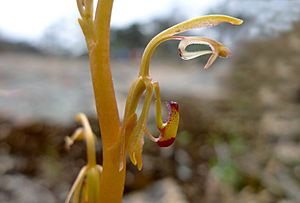Elbow orchid facts for kids
Quick facts for kids Elbow orchid |
|
|---|---|
 |
|
| Spiculaea ciliata growing on Boyagin Rock | |
| Scientific classification | |
| Genus: |
Spiculaea
|
| Species: |
ciliata
|
| Synonyms | |
|
Drakaea ciliata (Lindl.) Rchb.f. |
|
The elbow orchid (scientific name: Spiculaea ciliata) is a very special type of plant. It's an orchid, which means it belongs to the amazing orchid family. You can only find this unique plant in the southwest part of Western Australia. It's quite unusual because it grows in shallow soil right on top of granite rocks. What's even more surprising is that it grows and flowers during the hottest months of the year. It also has a super cool and unique way of getting pollinated by tiny wasps!
Contents
What the Elbow Orchid Looks Like
The elbow orchid, Spiculaea ciliata, is a perennial plant. This means it lives for more than two years. It's also a deciduous plant, so its leaves fall off at certain times. It grows from a small, oval-shaped tuber (like a potato) that is underground. This tuber helps the plant store food and water.
The plant has a single leaf that grows from its base. This leaf is about 2 centimeters (0.8 inches) long and 1 centimeter (0.4 inches) wide. It's a bit purplish on its underside. The leaf grows fully before the flowers appear, but it usually withers (dries up) before the first flowers open in late October.
The elbow orchid has up to ten flowers. These flowers grow on a thin, wiry stem that is about 10 to 18 centimeters (4 to 7 inches) tall. The stem gets thicker near the top. Each flower is straw-colored and about 20 millimeters (0.8 inches) long and 10 millimeters (0.4 inches) wide.
Orchids have special flower parts. The top part, called the dorsal sepal, curves over the flower. The two side sepals are a bit shorter. There are also two petals, which are narrower than the sepals. One petal is very special and is called the labellum. In the elbow orchid, the labellum looks like a wingless insect. It's attached to the flower by a flexible, hinge-like part. This labellum is small, fleshy, and covered in many club-shaped hairs.
The parts of the flower that help it reproduce are joined together in a structure called the column. This column has wing-like parts on its sides. The elbow orchid flowers from October to January. After flowering, it produces a dry fruit called a capsule. This capsule contains many tiny seeds.
How the Elbow Orchid Got Its Name
The elbow orchid was first officially described in 1840 by a scientist named John Lindley. He published his description in a book called A Sketch of the Vegetation of the Swan River Colony. Later, in 1871, another scientist, Heinrich Reichenbach, tried to put it into a different group of orchids called Drakaea.
However, in 1989, two other botanists, David Jones and Mark Clements, decided that this orchid was unique enough to have its own group again. So, they brought back Lindley's original name for it.
The name of the group, "Spiculaea", comes from a Latin word, spiculum. This word means "a sharp point" or "a sting." It probably refers to a small pointy part at the end of the labellum. The second part of its scientific name, "ciliata," also comes from Latin. It means "eyelash" or "eyelid." This refers to the long hairs found on the sides of the labellum, which look a bit like eyelashes.
Where the Elbow Orchid Lives
The Spiculaea ciliata grows in shallow, sandy soil. You can find it on top of granite rocks in several areas of Western Australia. These areas include the Darling Scarp, Paynes Find, and Mount Ney. It lives in different types of natural areas, like the Avon Wheatbelt, Coolgardie, Esperance Plains, Geraldton Sandplains, Jarrah Forest, and Mallee.
How the Elbow Orchid Interacts with Nature
The flowers of the elbow orchid are often described as "bizarre" or very strange. It's also unusual that they flower during the hottest months of the year when many other plants are struggling. One person, Nikulinsky, even said: "When most other plants [are] dead or dying, this tiny orchid [is] at its fascinating best. When everything else [is] brittle underfoot these are still succulent."
The elbow orchid has a super clever way to get pollinated! It's thought to be pollinated by a male thynnid wasp from a group called Thynnoturneria. The orchid's labellum (that special petal) actually smells like a female wasp's pheromone (a chemical signal). This smell attracts the male wasp from far away.
When the male wasp gets close, the labellum looks just like a female wasp resting on a blade of grass. The male wasp tries to pick up this "dummy" female to fly away with it. As it does, it rises into the flower's column. The column has wing-like structures that hold the wasp in place. While the wasp is held, its body touches the parts of the flower that contain pollen, helping the orchid reproduce. It's a very tricky and effective way for the orchid to get help from the wasp!
Conservation Status
The Western Australian Government's Department of Parks and Wildlife has classified the elbow orchid as "Not Threatened." This means it's not currently in danger of disappearing.
See also
 In Spanish: Spiculaea para niños
In Spanish: Spiculaea para niños

